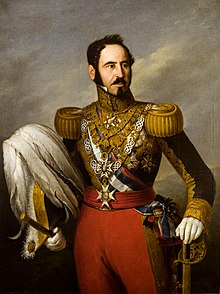Baldomero Espartero
| Baldomero Espartero | |
|---|---|
| Prince of Vergara Regent of Spain |
|

Portrait by Antonio María Esquivel (1841)
|
|
| Regent | October 17, 1840 – July 23, 1843 |
| Spouse(s) | María Jacinta Martínez de Sicilia y Santa Cruz |
| Father | Manuel Antonio Fernández Espartero y Cañadas |
| Mother | Josefa Vicenta Álvarez de Toro y Molina |
| Born |
27 February 1793 Granátula de Calatrava, Ciudad Real, Spain |
| Died | 8 January 1879 (aged 85) Logroño, La Rioja, Spain |
Don Joaquín Baldomero Fernández-Espartero y Alvarez de Toro, 1st Prince of Vergara, 1st Duke of la Victoria, 1st Duke of Morella, 1st Count of Luchana, 1st Viscount of Banderas (27 February 1793 – 8 January 1879) was a Spanish general and politician, who served as the Regent of Spain. He also served Prime Minister of Spain three times. He was associated with the radical (or progressive) faction of Spanish liberalism and would become their symbol and champion after taking credit for the victory over the Carlists during 1839. His noble title, Duke of La Victoria was granted by Isabella II to him as a result. The title Prince of Vergara was granted to him by King Amadeo of Spain during 1870.
Espartero was born at Granátula de Calatrava, a village of the province of Ciudad Real. He was the ninth child (two of them were Francisco and Antonia) of Manuel Antonio Fernández-Espartero y Cañadas, a carter, who wanted to make him a priest, and wife Josefa Vicenta Alvarez de Toro y Molina. At age fifteen, Espartero enlisted in a battalion of students to fight against the armies of Napoleon. During 1811, Espartero was appointed a lieutenant of engineers in Cádiz, but having failed to pass his examination he entered a line regiment. During 1815 he went to South America as a captain serving with General Pablo Morillo, who had been made commander-in-chief to quell the rebellions of the colonies on the Spanish Main. For eight years, Espartero distinguished himself in the struggle against the colonists. He was wounded several times, and was made major and colonel on the battlefields of Cochabamba and Sapachni. He had to surrender to Sucre at the final Battle of Ayacucho, which ended Spanish rule. He returned to Spain, and, like most of his companions in arms, was discredited for some time. He was sent to the garrison town of Logroño, where in La Rioja he married on 13 September 1827 the orphaned daughter of a rich landowner named Ezequiel Martínez de Sicilia y Ruíz de la Cámara (1786–1812) and wife María del Carmen Anacleta Santa Cruz y Oribe (1786–1816), Doña María Jacinta Martínez de Sicilia y Santa Cruz, born there on 16 August 1811 and who eventually survived him, dying during 1878, without issue. Henceforth, Logroño became the home of the most prominent of the Spanish political generals of the 19th century.
...
Wikipedia
